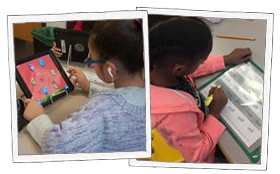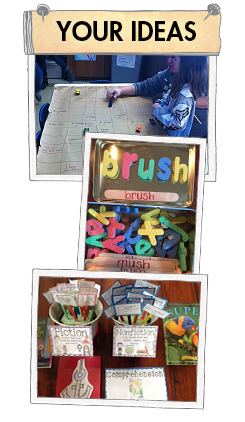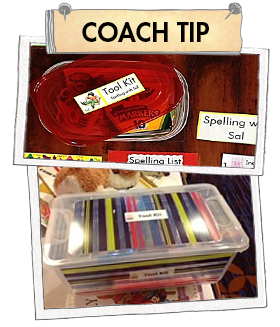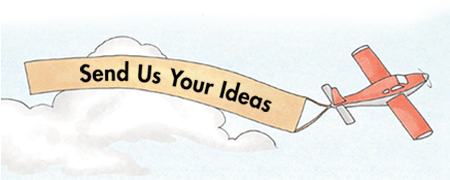In this issue: Classroom management tips and ideas for meaningful independent activities
|
|
|
|
ISSUE 6 | JAN. 2020
|
Reading lessons in The Superkids Reading Program are designed to be delivered to small, skills-based groups. One of the most frequently asked questions from Superkids teachers is, “What are the other kids doing when I am working with my groups?”
In this issue, we will explore tips for managing the classroom during independent work time and activities that will keep your students busy—with a purpose.
|
|
|
 |

|
|
|
|
|
Anchor stations can help cut down on planning time and the time spent giving directions for brand-new tasks each week or unit. Anchor stations are independent stations or cooperative centers with tasks that essentially stay the same all year. You only need to make small adjustments to allow the stations to grow and change as you move through Superkids.
|
  |
|
Anchor stations can help cut down on planning time and the time spent giving directions for brand-new tasks each week or unit. Anchor stations are independent stations or cooperative centers with tasks that essentially stay the same all year. You only need to make small adjustments to allow the stations to grow and change as you move through Superkids.
|
Here are a few fellow Superkids teachers’ anchor station ideas to get you started:
Hot Rod’s Reading Race: This teacher keeps this game board out all year. Students read decodable words or sentences provided on cards. If decoded correctly, the student rolls the die and moves the car ahead that many spaces on the board. To keep this station up to date, create new game cards to match the current unit.
Word-Building Activities: This first-grade teacher uses cute word-building boxes as an anchor station all year. Students who need more support use the word sticks to recreate the word and read the word to a partner. Students who need less support build the words that a partner reads aloud. Keep the station current by changing the sticks to include words with new phonemes as they are taught.
Reader’s Response Flowerpots: In this second-grade classroom, reflective questions about fiction and informational text are introduced and added to flowerpots one at a time. For this independent reading station, students pick one question from the flowerpot and respond on a provided “reader’s response” sheet. Provide fresh text to keep this station current.
|
|
|
Setting up a reliable system for assigning student tasks during independent work time is so important!
Students need to have a clear understanding of where to go and what to do when you are meeting with small groups. These photos show some of the task assignment examples we have seen in Superkids classrooms.
|
|
|
 |
|
  |
|
If your independent work time includes centers or stations, Superkids coach Ann Buis suggests creating a tool kit for each station. The self-contained tubs should include all materials needed to complete independent tasks such as pencils, crayons, markers, scissors, paper, or glue.
Ann also suggests making students responsible for keeping the supplies in tip-top shape for the next group. For example, if a glue bottle is empty, it is the group’s responsibility to make sure it is replaced for the next group.
|
|
|

When you are working with a small group for guided reading or additional skill instruction, here are nine suggestions for independent Superkids activities:
1. Project Corner—Kindergarteners can do activities in a Project Corner in your classroom. For every unit, the Student Book Teacher’s Guide explains how to set up a Project Corner that relates to special interests of the Superkids.
2. Handwriting—Kindergarten and first grade students can copy the text from the Daily Handwriting Routine in the lesson. Display the letters, words, or sentences on the board or in a center.
3. Big Books—Partners can take turns reading aloud words from the Big Book of Blending or Big Book of Decoding to each other.
|
|
|

|
4. Practice Pages—Children can complete Practice Pages that accompany the unit.
5. Reading—Children can independently reread text they read in their small group or read it with a partner. They can also read or reread texts from previous units.
6. Reader Response—Students in kindergarten or first grade can write and/or draw in response to a question about the text they have read in small groups. Second-grade students can respond in their Book Talk Journals.
7. Superkids Online Fun—Children can play games that correspond to unit skills and reread text alone or with a narrator.
8. Vocabulary—Students in first and second grade can write sentences and draw pictures to demonstrate their understanding of Words to Know or spelling words taught in the unit. Lessons provide prompts you can use.
9. Spelling—Children can write sentences using their spelling words or practice their weekly spelling words with a partner.
Remember to always check the written work students do independently and give corrective feedback as needed. Without feedback, the mistakes they make can become permanent bad habits. Checking their work also shows children that the work is important and valued, which encourages them to do their best.
|
|
 |
|
|
|
|